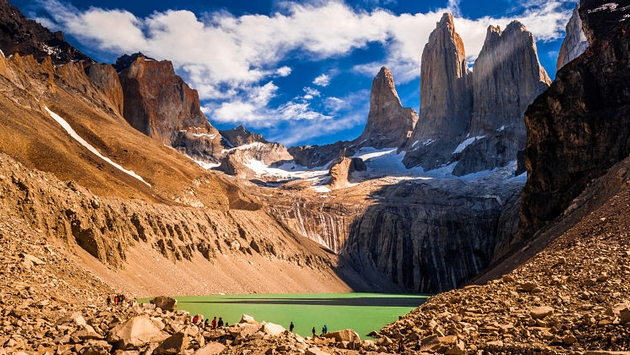

Chile continues to make good on its 2015 pledge to create new opportunities for travel within the country along with its dedication to sustainable tourism.
The country is pushing the limits of its commitment to preserving its natural treasures by dedicating more land and resources to the development of an epic route that will link a number of the country’s national parks.
For such a small country—and a narrow one—it boasts an abundance of protected land.
There are more than 35 national parks in Chile, not including its natural reserves and monuments, and these protected areas encompass a truly massive amount of space of more than 54,000 square miles.
The parks also create a wide variety of opportunities for visitors, ranging from adventurous pursuits in Patagonia to birdwatching in the altiplano:
Torres del Paine National Park
Torres del Paine is probably Chile’s most well known national park. It is also one of the largest, encompassing mountains, glaciers, lakes and rivers in the nation’s southern Patagonia region.
Visitors flock to the park in great numbers. More than half of the tourists here are foreigners who come from around the world to see the area’s brilliant blue glaciers and iconic towering peaks.
Chiloe National Park
Chiloe occupies an incredibly diverse landscape, and the park is divided into two regions: Chepu and Anay.
Anay, the larger of the two, is in the foothills of the Chilean Coastal Range and is home to dunes, forests, swamps and peat bogs.
The park is dominated by its Valdivian rain forest, and its main attractions are the Cucao Lake, coastal dunes and colonies of sea lions.
Rapa Nui National Park
Rapa Nui is a UNESCO World Heritage Site as well as a national park, and it draws in visitors who come to see the more than 850 moai statues that date back as far as 300 A.D. The park occupies much of the island and is under the control of Corporacion Nacional Forestal, which provides legal protection for the entire island.
Activities for visitors include hiking, trekking, mountain biking, horseback riding and more in addition to admiring the mysterious statues.
Lauca National Park
Travelers to Chile’s altiplano will want to explore the wonders of Lauca. Located in the far north portion of the Chilean Andes, the park has Las Vicunas National Reserve and Salar de Surire Natural Monument as its neighbors and, all together, they form Lauca Biosphere Reserve.
It is one of the best national parks for birding, with more than 140 species, including Andean goose, giant coot, silvery grebe, Andean condor and Chilean flamingo. Wildlife sightings, in addition to birds, include vicunas, llamas, alpacas and more. The park is also home to a wide variety of unique vegetation that has adapted to the harsh, dry environment of the region.
Parque Pumalin
Parque Pumalin will be one of the largest parks, and its recognition has sparked a number of development opportunities within the country’s national parks system.
Pumalin is not a national park yet. It represents 1 million acres that are now nationally recognized and protected—a gift from the Douglas Tompkins’ estate. An avid adventurer, conservationist and a co-founder of the North Face, Tompkins purchased a vast swath of land in Chile’s Patagonia region to ensure the region remained untouched, and it was donated to the government after his passing.
The future park will be joined with 10 million acres of federal lands to create a series of national parks that will encompass more than 11 million acres and include virgin forests, volcanoes, wild coastline and more now under strict environmental protection.
The region will become part of the Route of Parks, where visitors will be able to navigate a lengthy span of more than 1,500 miles of roadway with access to 17 different national parks.
courtesy= .travelpulse.com

